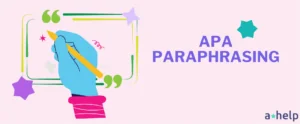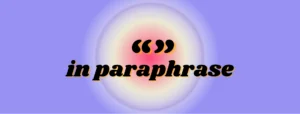Paraphrasing is a skill in academic and professional writing that involves rephrasing someone else’s ideas in your own words while preserving the original meaning. This technique is usually used to avoid plagiarism, a serious offense that can lead to severe consequences up to expulsion. This guide will help you with the knowledge and tools to paraphrase without falling into the trap of plagiarism. Don’t worry, we also have examples!

✅ AI Essay Writer ✅ AI Detector ✅ Plagchecker ✅ Paraphraser
✅ Summarizer ✅ Citation Generator
When Paraphrase Turns into Plagiarism
To put it simply, paraphrasing becomes plagiarism when it’s done incorrectly or unethically. Because of this, the source gets misrepresented and people attribute somebody else’s ideas as one’s own without proper attribution. This can happen in several scenarios:
| ⚠️ Too Similar to the Original Text | If the paraphrased text is too close to the original, just changing a few words here and there without substantially altering the structure or the language used, it can be considered plagiarism. Effective paraphrasing should involve significant (!) rewording and restructuring of the original text. |
| ⚠️ Lack of Citation | Even if you paraphrase a text by changing its wording and sentence structure, failing to cite the original source is plagiarism. Write a proper citation, as it acknowledges the original author’s contribution and distinguishes your own ideas from those of others. |
| ⚠️ Misrepresenting the Source Material | Incorrectly paraphrasing in a way that changes or distorts the original meaning can also be seen as a form of plagiarism. This is because it misrepresents the author’s ideas and intentions, and is misleading to readers about the content or implications of the source material. |
| ⚠️ Over-reliance on the Original Text | Even with paraphrasing and citation, relying too heavily on the structure and ideas of the original text without adding your own analysis or interpretation can be problematic. This approach can be seen as an attempt to present another’s work as your own, especially in academic and professional contexts where original thought and critical engagement with sources are expected. |
Understanding Paraphrasing
Paraphrasing allows you to explain ideas in your own words, so that you understand the source material and can communicate its essence without copying verbatim. For example, the famous line “To be, or not to be, that is the question” might be paraphrased as “The dilemma is whether to exist or cease existing.”
Recognizing when paraphrasing crosses the line into plagiarism is needed for upholding ethical standards across various fields. While paraphrasing aims to reinterpret source material in new language, certain practices can inadvertently or deliberately transform it into an act of plagiarism. Below, we explore specific situations where paraphrasing, if not conducted with care and due diligence, might be flagged as plagiarism. This awareness can help individuals navigate the fine line between legitimate use and unethical copying.
| 📝 Academic Writing | 🔬 Research | ✍️ Content Creation | 📑 Professional Documents |
| When students paraphrase source material without sufficient alteration or without citing the original work, it’s considered plagiarism. Academic standards require that paraphrased material be both properly cited and substantially different from the source. | Researchers must accurately represent their findings and those of others. Paraphrasing without proper citation or without significantly changing the language and structure of the original work is unethical and considered plagiarism. | Journalists, bloggers, and content creators who paraphrase others’ work without adequate attribution or who do not sufficiently modify the original content can be accused of plagiarism. This not only applies to text but also to ideas, data, and multimedia content. | In professional settings, using paraphrased material from reports, presentations, or documents without acknowledging the source or without making significant modifications can lead to accusations of plagiarism and damage one’s reputation and credibility. |
How to Paraphrase Effectively
In the next section we’ll look at some practical strategies and techniques designed to help you transform original texts into fresh, original compositions without losing the message. You can make sure your paraphrasing efforts are both ethical and impactful and enhance the clarity and originality of your work by trying out some (or even all) of the tips below.
Use of Synonyms
Using synonyms is one of the simplest yet most effective ways to paraphrase. It involves identifying key words and replacing them with words that have similar meanings. This technique is particularly handy in academic writing where precision is of high priority.
| Original |
| “Global economic policies must address the widening gap between the rich and the poor.” |
| 👌 Paraphrased |
| “Worldwide financial strategies need to tackle the increasing disparity between the affluent and the impoverished.” |
This example shows how synonyms can change the text’s appearance while preserving its original meaning, so that you are able to demonstrate an understanding of the topic without copying the source verbatim.
Change of Parts of Speech
Changing the grammatical role of words in a sentence can really change its structure without messing up its meaning. This method requires a good grasp of grammar and vocabulary.
| Original |
| “The investigation by the committee revealed several inconsistencies in the report.” |
| 👍 Paraphrased |
| “Several inconsistencies in the report were uncovered through the committee’s investigation.” |
This paraphrase changes the active voice to passive, altering the sentence structure and focus without compromising the original information, thus avoiding plagiarism.
Rearranging Sentence Structure
Rearranging the order of information in a sentence or paragraph can make your writing unique. This might involve starting from a different point in the sentence or breaking it down differently.
| Original |
| “When he finally returned to his homeland, the soldier found it hard to adjust to civilian life.” |
| 👏 Paraphrased |
| “Adjusting to civilian life proved difficult for the soldier upon his return to his homeland.” |
By changing the sentence structure, the paraphrase conveys the same message in a fresh manner, but shouldn’t be considered plagiarism.
Addition or Removal of Pieces
Adding or omitting details can tailor the paraphrase to the specific context of your writing while making sure it remains true to the original source’s intent.
| Original |
| “The rapid deforestation of the Amazon is due to various factors, including logging, agriculture, and cattle ranching.” |
| ✅ Paraphrased |
| “Logging, agriculture, and cattle ranching have led to the swift clearing of the Amazon forest.” |
This paraphrase focuses on the causes rather than the effect, provides a short explanation and avoids plagiarism by not copying the structure of the original text.
Tips for Effective Paraphrasing
After exploring the nuances of paraphrasing, let’s look at some tips and suggestions on how to be confident in your paraphrasing. A key aspect of this is understanding the importance of citations and referencing, which not only validate your work but also pay homage to the original thinkers behind the ideas you are conveying. SO, how can you properly cite and reference your sources after paraphrasing?
Citations and Referencing
Citing sources correctly is extremely important in paraphrasing. It acknowledges the original author’s work and avoids plagiarism. Make sure that you understand the citation style required by your institution or publication.
Citation: After paraphrasing a passage, include an in-text citation like (Smith, 2020) or a footnote/endnote, depending on the citation style used.
Practice Strategies
Regular practice can really improve your ability to paraphrase effectively. Use diverse sources for practice, from scholarly articles to popular media, and compare your paraphrases with the original to train your proficiency.
Exercise: Choose a paragraph from a news article and attempt to paraphrase it. Then, check your paraphrase against the original to ensure it’s sufficiently distinct and accurate. Share your paraphrase with peers or mentors for feedback.
Remember, the key to successful paraphrasing is understanding the source material thoroughly, using various techniques to rephrase it, and always citing your sources. By adhering to these principles, you can enhance your writing and academic integrity.
FAQ
Follow us on Reddit for more insights and updates.





Comments (0)
Welcome to A*Help comments!
We’re all about debate and discussion at A*Help.
We value the diverse opinions of users, so you may find points of view that you don’t agree with. And that’s cool. However, there are certain things we’re not OK with: attempts to manipulate our data in any way, for example, or the posting of discriminative, offensive, hateful, or disparaging material.